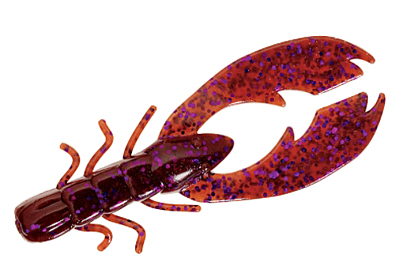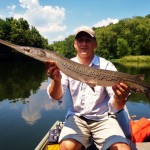By: Todd Wendorf – Date Posted: July 19, 2011
Life is full of choices. Should I buy a different truck now or run this one until it drops? Should I fill up the tank today or wait for gas to raise to $4.29 a gallon tomorrow? Should I buy my wife a nice birthday present of just be happy with frozen dinners for a year? Some choices are easier than others, but none the less … they all have to be made.
The world of bass fishing offers a lot of choices as well. Crank baits or plastics? Top waters or stick baits? Wacky hooked or Texas rigged? Braided line or fluorocarbon? Spinning rods or bait casting? $35,000 bass boat or $90 pair of waders?
Wait … what? Waders for bass fishing? Are you serious? Yes, I am. I’m totally serious, especially if you really want to catch number of big bass in heavily fished lakes.
A few years ago my beautiful wife of 27 years finally conceded. “Honey, I think it’s time for you to buy a boat.” (No, seriously … that’s what she said!) Ten minutes later when we entered the showroom of a local boat dealership we BOTH changed our minds. I’m sorry, but if I hope to retire before I’m 80 a new bass boat is probably out of the question. I love to bass fish, but not at that price!
So, how do I pull this one off? The answer came on Memorial Day weekend just a few weeks later when I spotted a number of fishermen catching bluegills on their beds on a local lake. Not being much of a pan fisherman, but really wanting to wet a line, I grabbed a few small slip bobbers and a box of wax worms and decided to join them. Well, the long and the short of it is, I gave up on the bluegill because they were constantly being chased off their beds by post-spawn largemouth that were on a feeding frenzy. As a matter of fact, those darn bass wouldn’t even leave my slip bobbers alone!
After having 3 slip bobbers destroyed by ol’ bucket mouth it finally dawned on me … “maybe I should try bass fishing? But wait. I don’t have a $35,000 bass boat! What to do, what to do?” Well, I eventually sloshed my way back into shore, grabbed a couple of Rapala DT-1’s from my box, and headed back out into the lake … in my waders. Three casts later (yes … three casts) I landed the biggest largemouth of my life … a hefty 22”, 6.5 lb slob that tried to do to my DT-1 what her friends had done to my slip bobbers.

Being a little short on time I was only able to catch 7 more fish that day, but the next I spent most of the day on the water and landed 54 largemouth, including five that were 18” or larger. I also lost one that put my 22” from the day before to shame. Keep in mind, this is not happening in Florida, Texas, or California, but southern Wisconsin where we grow them “lean and mean” compared to the southern states. Fish 18” and larger are quality fish and not that easy to come by. Apparently, I was on to something. Throughout the course of the next 4 months I was able to land over 600 largemouth, including 20 fish that were at least 20” in length. It was truly an amazing summer for a guy in a pair of waders.

Tradition says that big summer bass in our northern lakes all head for deep water. Of course, there’s also a tradition that says that fish lose their teeth in the summer. Both traditions are hogwash! Yes, some bass do head to deep rock flats and shelves when the water temperature rise, but I can assure you that there are also more bass in the shallows than you shake a stick at. And by shallows I mean anywhere from 6” of water on up, depending on the availability of shade, wind direction, and air and water temperatures.
In the lakes of southern Wisconsin I’ve found that post-spawn females tend to migrate to the large, sprawling flats of milfoil that exist in most larger lakes. These fish tend to roam and feed during low-light and no-light conditions and bury their noses in cover during the day. When the sun goes down and the wind goes with it … these flats come alive with insect hatches, bluegill and crappies feeding on insects, and largemouth eating anything in sight while trying to regain their strength.

The milfoil does not generally reach the surface of the water until early to mid June, giving the wade fisherman a great opportunity to fish these flats with shallow running crank baits like the Rapala DT-1 series and X-Raps. Bulging the surface on a calm night draws a lot of attention, the kind a bass angler is looking for. Slow sinking plastics like Berkley Gulp Sinking Minnows hooked Texas style, Trigger X Aggression Frogs, and Banjo Minnows worked slowly over the tops of the weeds on cooler nights can be too much for even a finicky eater to resist.

Significant winds will also produce activity. Throwing jerk shad and other stick baits onto wind swept flats can be magical. I believe the wade fisherman has a significant advantage in the wind as he doesn’t have to cast and control a boat all while waiting for the slight “tick” of a bass inhaling a soft plastic bait. Waders also don’t produce the steady vibration of a trolling motor and allow you to sneak through the milfoil beds without being noticed if you take your time and be patient.
Later in the summer I turn my attention to fishing under docks and pontoon boats. When the high suns of July and August beat down on the lake bass head for cover and shade. Having fished docks in waders for a number of years now I am totally convinced that I can out-fish most boat bound anglers simply because I’m lower in the water, can see better under the docks, and can present a bait to my target much easier because it’s right there in front of me. Once you get your nose under those docks you start to learn the idiosyncrasies of bass location under different circumstances. For example, I’ve learned that fish tend to locate on the inside corner of an L-shaped dock if there’s a post on that corner. If not … they tend to locate near the first post located between the L and the shore. That can change, however, depending on whether or not there is a boat tied to the dock. And don’t forget about wind velocity and direction, the angle of the sun, and water clarity. It sounds complicated, and it is. Now imagine how much more complicated it is if you don’t even know for sure where the posts are!


Please don’t get me wrong … boat anglers are still going to catch their share of fish, and sometimes even the hogs. But your odds increase significantly once you truly understand what’s happening under that dock in terms of structure, shade, and depth.
Once you learn the docks, you’ll catch a ton of bruiser bass. Finesse baits such as wacky and shaky worms, jigs with crawfish tails, and Banjo Minnows have been the biggest producers for me. Again, I prefer Gulp Sinking Minnows and Berkley Power Bait Chigger Craws. Experiment with colors to find out what works best in your lake under the current water conditions. Fish the full length of the dock until you discover a pattern, and then watch for changing conditions. I’ve caught fish in 6” of water under a dock on a bright sunny day, and I’ve found them way out on the end of the structure on cloudy days. You just never know until you fish it all.
You’ll find largemouth tend to hold in this seasonal pattern until surrounding weed flats begin to die off because of cold water temps and limited sunlight. Just don’t give up too early. Those falls days of September and early October can be incredibly productive. Fish tend to move back to the open flats in the fall, and the same baits and techniques used in the spring will work once again.

Fishermen have a lot of choices to make. If you’re fortunate enough to own the boat of your dreams, good for you. If not, I hope you know how lucky you are! Strap on your waders and head to the lake. Your dreams await you! You have the opportunity to maximize your fishing stealth, get down in the trenches with ol’ bucket mouth, and do some hand-to-combat with the fish of a life-time. Nothing is more exciting than having a “biggen” circle you in the water or turn you into a pretzel as she swims between your legs. Don’t give up because your waders don’t throw off a huge rooster tail and you’re not catching bugs in your teeth at 60 miles an hour. Just smile and wave as the other fishermen look at you like your crazy … and enjoy making the right choice!
Todd Wendorf grew up in Northern Wisconsin and now calls McFarland, WI home. He is an avid bass fisherman who specializes in shore fishing, wading, float tubing, and kayak fishing. When not chasing big largemouths, Todd frequently fishes for steelhead and brown trout in Southeastern Wisconsin harbors & tributaries. You can visit Todd online at http://www.needtofishmore.blogspot.com/






